| |
Russian Revolution's Forum
E-books World history, Rus' history and Religions history
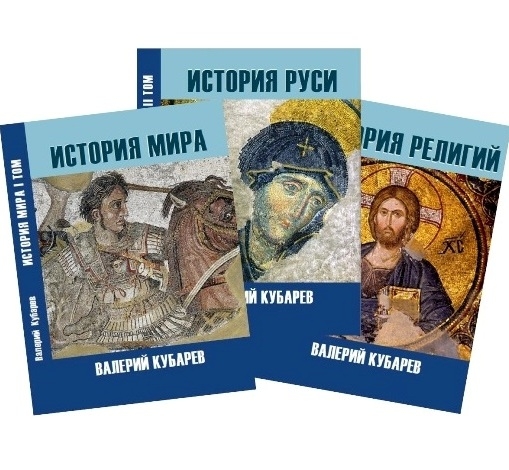
Modernization of Russia
Holy Russia - Third Rome
The new subject of international law, the State Holy Russia - Third Rome, 21.09.2013. | Nova Church of Holy Russia
Orthodoxy and Christianity require reforming and release of heresy and obscurantism. 21.09.2011. | Ethnopolitical transformation of Russia New!!!
The author investigates the deep ethnic and political processes occurring within Russian society. Russian statehood and the people are at a historical crossroads. The path chosen by the authorities leads to a dead end of a renewed Kyrgyz Khaganate. The alternative will allow the Russian people to achieve a European renaissance and rid themselves of barbarism and savagery. 08/26-09/06/2025. | The Seljuk Dynasty Origin New!!!
The author put forward a hypothesis according to which the Seljuk’s Sultans came from the Princes of the Russ – Rurikovich Kin, who eventually converted to Islam. The hypothesis was fully confirmed by the identification of the main historical figures of the Seljuk dynasty with the descendants of the Princes St. Vladimir and Yaroslav the Wise. We are talking about the rulers of Sultanate of Rum Sultan Suleiman and his descendants, as well as Tuqaq, Seljuk, Mikail, Israel, Toghrul, Alp Arslan and other Sultans. Princes and their sons from the Principality of Tmutarakan became Seljuk’s Sultans, from where they conquered the countries and peoples of the Caucasus, Iran, Asia Minor and Central Asia. 24.05–12.06.2023. | Synchronization of historical and religious Chronicles
The author correctly synchronizes historical and religious Chronicles of the Ancient World based on a short chronology and linking events to unique celestial phenomena reflected in the annals and Scriptures. The author believes that discrepancies in dates, geographical localities and ethnic origin of historical and religious figures are due to erroneous traditional chronology and historical geography, as well as the deliberate adaptation of phenomena and events to an established paradigm. 20.04–25.05.2020. | Astronomical dating of Biblical events
The author's reconstruction of the history and chronology of religions is fully verified by identifying 15 celestial phenomena described in the Chronicles, including 11 Solar Eclipses, 3 Zodiacs and 1 Supernova. A chronological shift of 1780 years in the history of Ancient Egypt has been confirmed for 6 phenomena, including 3 Solar Eclipses and 3 Zodiacs, including the Eclipse of Pharaoh Takelot on August 8, 891. Astronomically confirmed the date of the Crucifixion of Jesus Christ as March 18, 1010, and the date of death of Ibrahim – the son of the Prophet Muhammad as February 7, 1152 (28 Shawwal 546 AH). 20.02–31.03.2020. | Origin of the gens Rurik
After the break of ties between the metropolis and the Russian principalities, the annals of Byzantium were cleared of the mention of "foreigners" in the management of the Empire, and the Chronicles of Russia did not have time to properly reflect the role of Rurik in world history. A study of the sources of Ancient Rome, New Rome, Russia, Arab countries, Danube and Volga Bulgaria allowed the author to identify the Russ gens and Bulgarian Khagans with the Flavian dynasty, as well as to identify Rurik, his descendants and relatives from the Macedonian dynasty (IX–XI century) and dynasty of Lecapenus (X century). The last Russian Emperor of New Rome been Yaroslav the Wise, throne name Constantine Monomachos. 11.09–21.10.2019. | Chronology of monotheistic religions
The author identified the Patriarchs of monotheism with well-known figures of human history. He proved that the oldest religion of monotheism is Christianity, which had a theoretical character in the I Millennium (Old Testament Christianity) and a practical embodiment at the beginning of the II Millennium (New Testament Christianity). Islam and Judaism emerged only in the early VII century and became radical branches of Christianity. Based on the study of solar eclipses, the author has determined the date and place of the Crucifixion of Jesus Christ (March 18, 1010 in Constantinople), the year of the death of the Prophet Muhammad (1152) and the period creation of the Quran (1130–1152). 01–27.08.2019. | Localization of Ancient Rome
The history of Ancient Rome is well studied, but hides a lot of inconsistencies and contradictions relating to the period of formation of the city and the expansion of the Romans into the world. We believe that the problems are caused by ignorance of the true localization of Ancient Rome in the Volga region on Akhtuba until the Fire on 64 and move city to location of Veii in Italy. The article also considers the aspects of ethnic origin of the peoples of the Latin League, Ancient Rome and Europe. The vector of expansion of Ancient Rome from the Volga region to the Europe coinciding with the migration flows of the Migration Period and the spread of PIE is substantiated. In addition the article considers the dynamics of growth and decline of the population of Ancient Rome in the localities from its inception to sunset and transformation. 23.06–16.07.2019. | Short chronology of Ancient Egypt
The history of Ancient Egypt generated in XIX century, every day finds out all greater discrepancy to modern realities both the newest archeological and tool data, including results of DNA researches of mummies of the Egyptian pharaohs. The chronology of Egypt as whole is considered well investigated and however it has been created for substantiation of an antiquity of Jewish people, instead of for scientific description of one of most ancient terrestrial civilizations. Author's reconstruction of chronology of Ancient Egypt has found out time shift at rate 1780 years in depth of centuries from true dating events. 1-16.06.2019. | Great Tartary or Slavic Empire
The next riddle of world historiography is solved. Present clause is devoted to history and modern condition of one of the most grandiose empires of terrestrial civilization – Great Tartary or Slavic Empires. 04–19.09.2017. | The European Aryans
In present clause the broad audience of the questions connected to probable Aryan origin of various European peoples is considered. Including aspects of possible an Aryan origin of Slavs and prospects of presence by these of special way to world around are considered. 25.02.2017 - 24.03.2017. | Summarizing of Zemsky Sobor 2016 (Land Assembly 2016)
Within the framework of carrying out Zemsky Sobor 2016 (Land Assembly 2016) on elections of Grand Prince of All Russia four Nominees have been put forward. The overwhelming majority of voices have been given for Nominee Grand Prince Valeriy Viktorovich Kubarev. Will of God and decision of participants of Assembly, Zemsky Sobor 2016 has elected lifelong Grand Prince of All Russia Valeriy Viktorovich Kubarev Grand Kubensky Rurikovich. 11.05.2016. | Yaroslavl’s Princes Rurikovich
In clause is described family tree of Grand Princes of Yaroslavl and their descendants, it is the senior branch of the Kin of Russ – Rurikovich, going back to Mstislav Great Monomachos. Kin of the Grand Princes of Yaroslavl have continued by Princes Grand Kubensky – Kubarev. 22.02.2016–11.03.2016. | All truth about Saint Prince Vladimir
In clause the all truth about Saint Prince Vladimir which is ignored Orthodox and Romanov’s historians, communistic historical science and their modern adepts, fabricating myths about Russ with « good intentions » opens without denominations. The kin of Russ - Rurikovich has created Orthodoxy and the Russian statehood, Russian people began to forget about it. Glory to Russ! 07-17.07.2015. | Brief chronology of religions
The report at XXX International conference on problems of the Civilization, 25.04.2015, Moscow, RosNoU. In the clause the final Chronological Tables of Ancient Egypt, Ancient and New Rome, Rome in Italy, Christianity, Islam and Judaism are submitted. 25.04.2015. | Canons of Orthodoxy of XIV century and the present time
The report at XXIX International conference on problems of the Civilization, 20.12.2014, Moscow, RosNoU. In the report the comparative analysis of canons of Orthodoxy of XIV century (1315-1321), displayed on mosaics and frescos of Church of Chorus in Istanbul, and modern doctrines are made. Numerous differences of events of the Holy Legend and the Gospel of the past and the present are found out. 20.12.2014. | Ethnic threats to peoples of Russia
In clause political, economic, cultural and religious aspects of consequences of ethnic opposition of radical peoples of Russia and new coming Slavic population formed as result of violent Slavic expansion in Russia in days of the Mongolian yoke are considered. The historical reasons of occurrence of ethnic contradictions are investigated, estimations of modern condition of problem (Chechelevskaya and Lubotinskaya Republics in 1905, Donetsk national republic and Lugansk national republic in 2014 in territory of Ukraine) are given and offers on decrease in escalation of ethnic opposition in territory of Eurasia are made. 09.06 - 05.07.2014. | Attribution of Rurikovich and Emperors Lecapenus
The report at XXVIII International Conference on problems of the Civilization is 26.04.2014, Moscow, RosNoU. In clause it is described detailed attribution of Ugrian Tsars with Emperors of Ancient and New Rome and Patriarches of terrestrial civilization. It is scientifically proved origins of all patriarches of monotheism and Emperors Flavius and Lecapenus from kint of Ugrian Tsars of Russ (Great), is the ethnic Finn-Ugrian from Volga region. 23.03.2014 – 24.04.2014. | Putin's Eurasian impasse
Vladimir Putin and Uniform Russia realize the Eurasian project, involving Russia and Russian people during stagnation and backlogs from World Civilization. They create Gog and Magog Empire, menacing to world peace. Why the Kremlin authority has not asked Russian Slavs – they want to live in the Asian country or to be safe Europeans? 14-22.01.2014. | Projections of the God in symbols of religion
As result of studying the extensive visual material created by 3D modeling, we have proved existence of uniform source of an origin of Projections of the God, that is religious symbolic of people. The source or quantum object refers to the Chariot of the God. We believe that on the basis of our researches, it will be possible to organize training to travel on the Universe of space navigators from the most gifted people and to create spaceships with engines as the described quantum generator is Chariots of the God or the Chariot of Cube. 25–30.08.2013. | Origin and migration of Slavs
Historical and genetic routes of migrations of the Slavs, calculated with the help from ancient Byzantium, European, Chinese, Arabian, Bulgarian and Russian chronicles and annals, and also modern researches of man's DNA chromosomes. 01-21.05.2013. | Empires of cousins of Russ
The report at scientific XXVI International conference on problems of the Civilization 26-27.04.2013, Moscow, RosNoU. In article five world Empires of cousins of Russ (Great) existing in our era on open spaces of Eurasia with cyclicity of occurrence once in 300 years are described. | Hungarian Kingdom of Russ
It is continuation of research of dynastic communications of Rurikovich. Cousin of Rurik Almysh/Almos and his children Kazan/Kurszan and Arbat/Arpad, it is all ethnic Ugrian of Russ, have based at the end of IX century – beginning of X century the Hungarian kingdom of Russ, having grasped Great Moravia. 08-11.01.2013. | Reconstruction of dynastic communications of Rurikovich in IX-XI centuries
Report at anniversary scientific XXV International conference on problems of civilization at 21-22.12.2012, RosNoU, Moscow. Corrected at 03.01.2013. | Educated Christianity of Russ
Bible – the Old Testament and the New Testament has exhausted itself. Forged the Scripts and the Sacred Legend cannot serve more as a spiritual reference point for promotion of mankind forward on the river of time. It is allowable to use only spiritual – moral potential of the ancient products being product of national creativity of Jews and Catholics, instead of divine revelations. The chronology of Bible events, an ethnic accessory of patriarchs of mankind, names, geography and original languages of heroes of the Bible do not correspond to the validity. Bible miracles have the quantum nature in the basis and submit to laws of a universe. Educated Christianity of Russ restore the religious both destroyed obscurantists religious and scientific knowledge of Christianity and revolutionary role of religion in history of civilization. 26.08. – 12.10.2012. | True Empty Tomb
Nova Church of Sacred Russia and Sacred Russ, Princes of Russia congratulates mankind on presence of True Empty Tomb and restoration of the religious and historical truth. The true has triumphed forever. 20-29.05.2012. | Orthodoxy and Islam in Old Russia
The report at XXIV International scientific conference on problems of the Civilization in Russian New University on April 20-21, 2012. | Day of Church Slavonic writing. Russ Cyril and Methodius.
In this significant holiday of Day of Church Slavonic writing and remembering Equal Apostles Sacred Cyril and Methodius, Princes of Russ convincingly ask Russian Orthodox Church and the public of the orthodox countries to return to sources and correctly to name the writing, language and church books Russian, but not Slavic. Ancient Russia was the Finno-Ugric state created by Russ Christians Rurik and Igor, Cyril and Methodius, Askold and Dir, Prophetic Oleg and Sacred Olga, Sacred Vladimir and Empress Anna Macedonian.
24.05.2011. | Wars of Russ in IX-XI centuries
In article on a rich actual material it is shown, that all wars of Russ with Byzantium in 836-1043 have been connected to deduction of a throne of empire by Russian party of Constantinople headed by the Macedonian dynasty of Russ. To the author it is proved, that two centuries co-emperors of New Rome were Great Princes Rurikovich. Last Russian emperor Jaroslav Mudry known in Tsar Grad as Constantine Monomakh was. The report at scientific XXII International conference on problems of the Civilization 22-23.04.2011, Moscow, RosNoU. | Genetic distances between cousins Rurikovich
The report at scientific XXII International Conference on problems of the Civilization, on April 22-23, 2011, RosNoU, Moscow, Russia. 24.04.2011. | Slavic-Mongolian invasion to Russia
Results of our research of an origin of Slavs have not simply scientific, but political value. In view of the received data it is necessary to form the weighed policy of interethnic and inter religious attitudes in Russia and the world. The modern hobby of Russian Slavs Rodoverie, the Aries origin and the contemptuous attitude to inhabitants of Central Asia, Caucasus, Mongolia, China and other regions of the world bears a system and logic mistake. Rodoverie in general it is senseless, in fact ancestors Rodoverian in Russia and Ukraine have left Central Asia and were Kirghiz, Altaian’s, Tajik’s, Pashtun’s, Uyghur’s and Juan-Juan, and completely not blond demigods. 12-18.03.2011. | Old Rome and Italic union of the Volga region
The scientific article on an extensive historical material proves that Ancient Rome has been created by Finno-Ugric tribe’s of Italic union of the Volga region (Idel, Bulgar). Italic peoples Vestini (Vesi), Marsi (Merya), Lucani (Lucane), Marrucini (Marri) and others till now live on Volga. Finno-Ugric named Latinas (Latinyanami) German peoples of the Volga region, differently Altyn-ami that means Gold literally. Fortress Alba Longo was called Altynbash, and Volga region Rome – Ulak-Urum. Southwest capital of Finno-Ugric of Idel was city Phanagoria or the Finn–Ugoria, being in antiquities capital Bosporus Empire and Great Bulgaria was. The web of lies of the western falsifiers of history how many would not be twisted, but to it all the same there comes the end. 10-21.02.2011. | Correct genographic
We have proved fidelity Bulgarian theory of an origin of mankind. She proves to be true a natural vector of moving of people on a planet from the Volga region in all parties of Eurasia, and there from to Africa, Australia and America. All peoples and races of the world have taken place from Hindi-European, namely – from ethnic Finno-Ugric. 01-07.02.2011. | Correct DNA-Genealogy and glottochronology
Scientific article of Grand Prince Valeriy Kubarev on DNA-Genealogy and glottochronology is submitted to your attention. The author has created formulas with which help it is possible to define precisely time of life of the general ancestor and an epoch of formation of various languages. These formulas have received the name of Kubarev’s formula. With the help of mathematical calculations, Valeriy Kubarev has proved fidelity Barrow of Hypothesis of Maria Gimbutas and own reconstruction of a history of the world. We hope that results of research will find wide application in DNA-Genealogy and glottochronology. 04-14.01.2011. | Genealogy and genetics of Princes of Russia
The report of Grand Prince Valeriy Kubarev at XXI International Conference on problems of the Civilization 25.12.2010. Valeriy Kubarev's scientific article describes genetics of Rurikovich and Sorts of Russia. Grand Prince has scientifically defined modal haplotype of Rurik, Gedimin, Russ Aydar, Kubrat, Flavius and has theoretically described modal haplotype of Alexander Great, Jesus Christ Zlatoust, Prophet Mohammed and Genghis Khan. All these well-known people ethnically Finno-Ugrian from the Sort of Russ. 25.12.2010. | What do we celebrate on November 4? Loss of the national sovereignty...
National voting or voting of national representatives is unacceptable for elections of Tsar and Grand Duke, in fact tsar from the God, and the voice of people is not a voice Divine. Elections of Grand Duke only voting of Princes – patrimonial aristocracy of Russia are possible. 08-21.11.2010. | Turn of the Earth promptly comes nearer
This is article with the analysis of abnormal geophysical and climatic activity on a planet. 09-12.09.2010. | Baltavar – a symbol of Christianity, an Islam and Judaism
Petrarca: « When people will address to the history, his greatness come to live »
30-31.03.2010 | History of Russ about 3506 BC till 2012
Kubarev V.V.'s report, History of Russ about 3506 BC till 2012.
Section «Civilization aspects of the Russian history and chronology».
Tenth International scientific conference «Civilization of knowledge: global crisis and an innovative choice of Russia», Moscow, April 24-25, 2009, RosNOU. | Archive 2006-2018 |
Whose fault is it?
The Catechon Paradigm as an instrument of the Antichrist New!!!
In the article, the author examines the current state of the catechon paradigm and the practice of using the provisions of the concept in the political and public life of the Russian Federation. According to the author, the idea of the catechon in Russia was intercepted by the forces of evil and used as a screen to cover their deeds. Today, the catechon paradigm has become an instrument of the Antichrist and his adherents to gain world domination. The only resource for Lucifer’s conquest of the world is sinful people whom he can attract under his banners. As successful as his deception and seduction will be, so strong and numerous will be the army of Satan. 05–17.12.2022. | Impairment of Orthodoxy New!!!
In the article, the author has carried out a retrospective analysis of the events and processes that led to the impairment and transformation of the canons of Orthodoxy and the patristic tradition of Russian Christianity. Prohibitions and reliance on the good intentions of opportunists within the body of the church led to a natural distortion of the teaching. As a result, the Orthodox Church became vulnerable to the pressure of Lucifer's lies and deception and ceased to be a source of life. 30.09–25.11.2022. | Features of Christianity in Cappadocia New!!!
The usual facts for Cappadocia were the proximity of male and female Monasteries and their communication. The plots and frescoes of the Churches were created no earlier than the first quarter of the XI century. The isomorphic images of St. George, Theodore Stratelates and Theodore Tiron have come down to us. According to the author, St. George became a collective image of the Saints Constantine the Great and the two Theodores. The fresco of the Serpent Church depicts Onuphrius the Great as a hermaphrodite, which the Church is trying to forget. On the face of the purposeful distortion by Christianity of the Holy Tradition, led by the Holy Spirit, and the removal from the original sources. 05–28.08.2022. | Emperors Lekapenos(920–945)
Based on a thorough analysis of the chronicles of New Rome, Ancient Russia, Great Bulgaria and Arab sources, the author has justified the Finno–Ugric origin of the Macedonian Dynasty and the Lekapenos Dynasty. The details of the biographies, names, dates of rule and family ties of dozens of Emperors, Khagans and Princes of Byzantium, Russ and Bulgar coincide with great accuracy, which makes it possible to identify all the studied personalities with real historical figures. In local chronicles, they have different or identical names, depending on the national characteristics of the nicknames of the studied persons. 07.12.2020–30.01.2021. | Dancing on bones (people losses of USSR in SWW)
We have found out the facts of direct falsification of human losses of military men and civil persons of the USSR within the Second World War in some millions person. Forgery is caused by activity of the propaganda machine of the USSR and false understanding of patriotism in modern Russia. By our calculations true irrevocable losses of the population of the USSR within the SWW make 7.6–8.7 million persons from among military men and the general losses with civil people 12.8–13.9 million persons. Have run away from Stalin paradise of USSR is hundred thousand (up to 1.3 million) the persons. We believe that the name of each victim of war should be taken into account and sounded publicly. 04–18.05.2019. | Expansion of Rome from Volga region
The report at XXXIII International conference on problems of the Civilization, 24.12.2016, Moscow, RosNoU. In the report the extensive information on resettlement of peoples to Europe through ports of Bosporan Kingdom and Bosporus to the Mediterranean from the Volga region, Siberia and Caucasus during existence of Ancient Rome in delta of the rivers Volga and Akhtuba since VI century B.C. up to middle of VI century is submitted. 24.12.2016. | Seleucus and tribal leaders of Rome
The report at scientific XXXI International Conference on problems of the Civilization has acted on December 26, 2015, RosNoU, Moscow, Russia. In the report the hypothesis that "Macedonian" gains of IV century B.C. actually are the first wave of expansion of Ancient Rome and resettlement of peoples on South, East and West from territory of the Volga region and Caucasus is put forward and proved. 26.12.2015. | Picturesque Gospel of Church of Chora (Kariye) in Istanbul
Research of artifacts of Church of the Christ Savior in Chora (Church of Chorus, XIV century, Istanbul) has allowed restoring overlooked nuances of ancient doctrines of Byzantium Orthodoxy. The numerous facts of distortion Holy Book and Holy Legend have been found out at formation of modern Christian canons which at all are not an inviolable reality from above, and there is product of human creativity. 15.09–08.10.2014. | Images ancient Romans from Volga in artefacts
Long millennia in Idel-Rome-Memphis-Mitsraim-Itil-Saray-Batu lived from 600 000 up to one million person. Ruins of city are grandiose pantry of a history, culture and religion. Masonic scientists diligently avoid carrying out there scale excavation. In those places prospers only black selector of treasures. How long it is possible to hide to world elite of impostors true from people? 20-22.04.2010. | Archive 2004-2018 |
What to do?
Sixth and other questions New!!!
Why doesn't the ROC want to stop the war? 14.02.2022. | Five questions to the ROC New!!!
The first question: What is the data of the Birth of Christ now?
The second question: When and where was Jesus Christ crucified?
The third question: When will the Apocalypse begin?
Fourth question: Why Tartarus and the Kingdom of The Beast located in Russia?
The fifth question: When did Vladimir Putin become the receptacle of the Beast? 24-27.01.2022. | The Prophet Muhammad and the Quran
Based on an independent analysis of artifacts, ancestral tree and astronomical phenomena related to the deeds, life and death of the Prophet Muhammad, as well as historical evidence of the first appearance and legal use of the Quran in the life of Muslims, the author drew conclusions about the integration of several historical figures of the VII and XII centuries into the personality of the Prophet Muhammad. They became Khagan Kubrat, aka Emperor Heraclius, the Arabian Prophet or Caliph of the Rashidun Caliphs and the true Prophet Muhammad, who lived in 1090–1052. The Quran was created in 1130–1152. The proposed interpretation does not undermine the canons of the faith of Islam, but establishes the truth. 11–30.11.2021. | Syncing the chronicles of Rome and Egypt
Based on a thorough analysis of details of military campaigns and astronomical phenomena from the chronicles of Ancient and New Rome, Ancient Egypt and Persian sources, the author confirmed the chronological shift in the history of Ancient Egypt by 1780 years in the past. The author also revealed the complot of historians to conceal the existence of Ancient Egypt in I millennium by masking the deeds of the Egyptian Pharaohs of the New Kingdom for the non-existent activity of the Kings of the Sasanian Empire. 06–29.03.2021. | The identification of the Patriarchs with historical figures
The author correctly identifies the Patriarchs of monotheistic religions with historical figures of the past based on the paradigm of a short chronology of the world and linking events to unique celestial phenomena reflected in Chronicles and Scriptural. The identification of the Patriarchs is based on the analysis of data from the genealogical trees of Jesus Christ from Lucas, Matthew, mosaics of the Church of Chora, the genealogical tree of the Prophet Muhammad and lists of the Kings of the Great Bulgaria. 21.07–27.08.2020. | Pure Relationship
We have found out and have proved that at everyone men are two direct lines of Pure Relationship on which in each generation of ancestors he has only one pair pure relatives – the forefather and the foremother. All other ancestors are the listed relatives. We also have proved that each woman has two direct lines of Pure Relationship on which in each generation of ancestors it has only one pair foremothers. On the basis of research we confirm De Facto firmness of the absolute law of succession is rule Lex Salica of Pure Relationship. 05.08 – 03.09.2014. | Archive 2004-2018 |
To be continued...
Thoughts aloud: Religion
Thoughts aloud: Politics
Thoughts aloud: Advice
Thoughts aloud
To be continued...
|
|
|
|
Valery KUBAREV > What to do? > Syncing the chronicles of Rome and Egypt
Syncing the chronicles of Rome and Egypt |
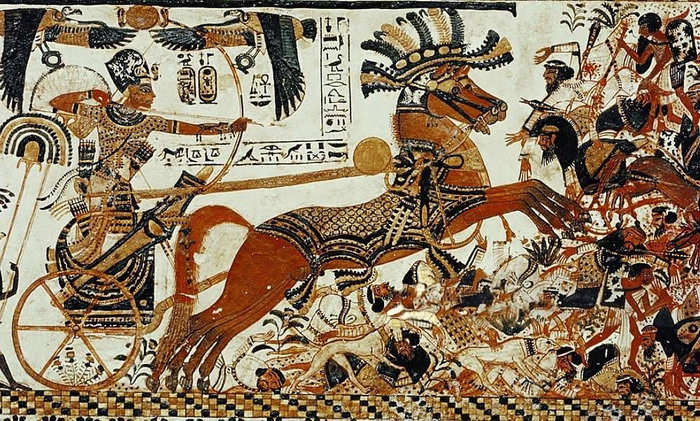
Kubarev V.V., Syncing the chronicles of Rome and Egypt, EESA #3 (67) 2021, Part. 4, pp. 4–16. Link: https://archive.eesa-journal.com/index.php/eesa/issue/view/29/59
DOI: https://www.doi.org/10.31618/ESSA.2782-1994.2021.4.67.5
| Summary: Based on a thorough analysis of details of military campaigns and astronomical phenomena from the chronicles of Ancient and New Rome, Ancient Egypt and Persian sources, the author confirmed the chronological shift in the history of Ancient Egypt by 1780 years in the past. The author also revealed the complot of historians to conceal the existence of Ancient Egypt in I millennium by masking the deeds of the Egyptian Pharaohs of the New Kingdom for the non-existent activity of the Kings of the Sasanian Empire. Keywords: Ancient and New Rome, Ancient Egypt, New Kingdom, Sasanids, Mitanni, Naharin, Hittites, Sherdens, Greater Israel, Kubrat. Statement of problem: In his research, the author discovered a chronological shift in the history of Egypt by 1780 years. The New Kingdom, according to the author, was created by the Gordian Emperors, ethnic Germans. However, according to traditional historiography, in the Middle Ages there is no mention of any activity of the Pharaohs, as well as the presence of evidence of large-scale military clashes between Roman, Egyptian and Persian troops. At the same time, there are many references to frequent Roman-Persian Wars that have no economic or geopolitical justification. The analysis of the last of research and publications: Behind the tons of literature about very Ancient Egypt, you can barely hear the statements and articles of scientists and archaeologists about the discrepancy between the facts of generally accepted dates. In Israel archaeologist Ze'ev Herzog claims that there are no artifacts older than I century in Israel. In addition the author's research proves that the history of Ancient Rome and Ancient Egypt are interconnected and has common beginning.
Allocation unresolved before parts of the general problem: The author previously synchronized the chronicles of Rome and Egypt, as well as Biblical history, astronomical phenomena, and biographies of historical figures of the past – Pharaohs, Kings, Emperors, and Patriarchs. The analysis of the dates, details and facts of the military companies involved in the history of the past: Ancient and New Rome, Egypt and Persia, remained out of sight. The purpose of clause: The purpose of this study is to synchronize the chronicles of Rome and Egypt by identifying the relationship between the facts, geography, and dates of the military companies involved in the history of the past: Ancient and New Rome, Egypt, and Persia. The basic material: In our works we adhere to the paradigm of the emergence of human civilization in the Volga region about 5500 years ago. This hypothesis was first proposed by Marija Gimbutas in 1956 [1–4]. In our research in 2009, we confirmed this theory by linking it to the outline of historical events of the past [5], and also clarified the chronology and localization of Ancient Egypt and Rome [6,7]. The author justified a short chronology of Biblical events and Monotheistic religions [8]. In addition our conclusions are confirmed with an accuracy of several years by a cascade of astronomical phenomena in ancient chronicles and Scriptures [9]. The work done made it possible to independently synchronize historical and religious chronicles [10].
The author claims that the factors of the Late Bronze Age collapse [11] in the Mediterranean region should have affected the Nile Delta, so the African civilization could also have perished. The discovered chronological shift in the history of Egypt by 1780 years allowed us to accurately determine the beginning of the history of Egypt and the future of Rome as 1188 BC – the flight of the Trojans under the leadership of Aeneas from the defeated city. The White Walls fortress – Alba Longa or Inebu Hedj was built around 1172 in the area between the Volga and Don rivers. The history and facts of the period before the Middle Kingdom of Egypt and the royal period of Rome are legendary and difficult to assess the military companies of the parties. The author has previously proved [6,7] that the Middle Kingdom of Egypt falls exactly on the dates of the reign of the Ptolemaic dynasty. This was followed by the era of the occupation of Egypt by the Hyksos (shepherd Kings of the Volga region and Asia), which the author accurately identifies with the Roman conquest of Egypt at the end of I century BC.
The Hyksos / Romans were driven out of Egypt by the Gordianus Emperors, ethnic Germans (Haplogroup R1b1), and natives of Egypt in the 240s. The Gordian’s became the founders of the New Kingdom when Gordian II and Gordian III became known as the Pharaohs Kamose and Ahmose I. The author proved [6] that the details of the biographies of the Pharaohs and Emperors have numerous coincidences. After the reign of the Gordianus (Gordian) Emperors, there is a documentary opportunity to analyze the details of the military companies of Egypt and Rome to synchronize the chronicles of the states.
We put all the relevant data in the Table No. 1, which reflects the events, dates and names of the rulers of their chronicles of Rome, Persia and Egypt, taking into account the chronological shift of 1780 years in the history of Egypt.
| 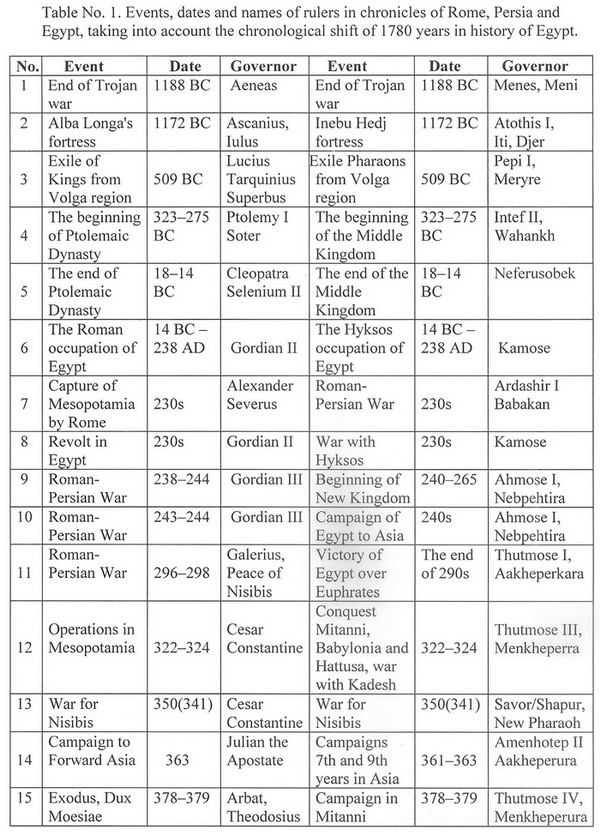
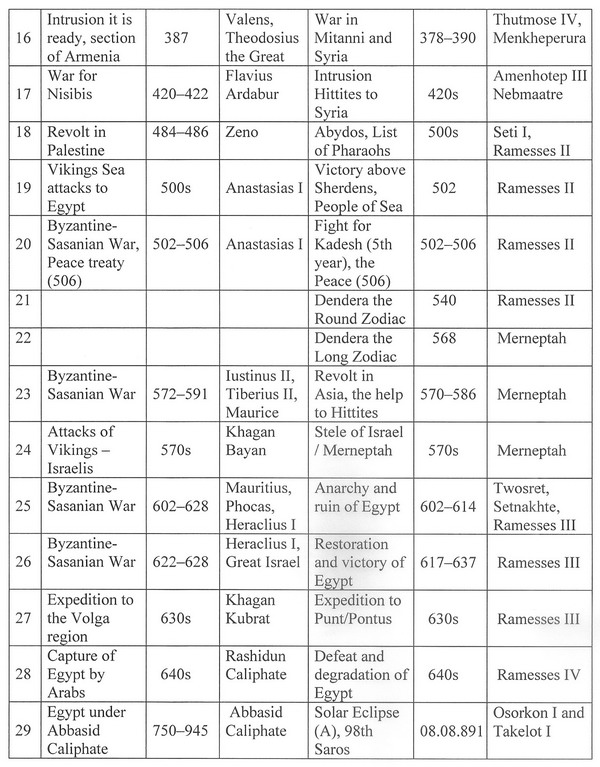
| The formation of the New Kingdom was accompanied by the first Sasanian War with Rome led by Alexander Severus [12] in 231–232. In parallel, in Egypt there was unrest over the separation of the country from Rome (Cossonius Scipio/Tao I, Gordian I/Tao II, Gordian II/Kamose and Gordian III/Ahmose I). After the death of Severus, the Gordian Emperors came to power as a result of the troubles, but they ruled in Africa, that is in Egypt and not in Rome.
Gordian I, Gordian II, and Gordian III fought the Roman and Numidian armies in western Egypt. The Pharaohs Tao II, Kamose, and Ahmose I fought the Nubians and Hyksos. The author believes that here the Nubians and Numidians are one people from the region of Carthage, and the translation of the Egyptian chronicles is erroneous. The Pharaohs rebelled against the Hyksos, who were Romans.
However, Gordian III / Yahmose I was already at war not only with the Nubians/ Numidians, but also with the Asians. The Pharaoh went to Syria twice, the last time at the end of his reign, and the Emperor undertook a Persian campaign in 244 and lost a battle to Persians in Mesopotamia. It is believed that he died there, but in fact Gordian III/Ahmose I returned to Egypt and reigned there until 265 [13].
Therefore, the wars of Rome with Persia of the period 244–265 are actually the wars of Egypt and Persia.
The next Roman–Persian War falls on 296–298. The troops of Rome were commanded by Galerius. He was captured by the royal wagon train and family members. The Peace of Nisibis (Nusybin) was concluded, according to which the Romans remained in Mesopotamia, and the border between the countries passed along the Tigris.
According to Egyptian sources, Thutmose I undertook a military campaign in Mesopotamia. The Persians were defeated, and lost many prisoners. After the victory, the Pharaoh established a Stele as the boundary of his possessions on the banks of the Euphrates [13]. Later Thutmose III found it and placed his Obelisk next to it.
In fact, we are talking about the war of Egypt and Persia, passed off as the Roman-Persian War. The description of this period of time in historiography needs to be refined perhaps Rome and Egypt were allies. However, it is more likely that the Egypt of the New Kingdom era was controlled by a weakened Rome.
During the period of peace between the Romans and the Persians, there was a serious war in Mesopotamia in 322–323 [14], when the Persian troops under the leadership of the King's son Narseh invaded Mesopotamia and were allegedly defeated by Constantius.
According to the author's reconstruction of the history of Egypt [5–7], in the 322–324, a large-scale military campaign of Thutmose III was carried out to capture Mesopotamia, the Hittite Kingdom and Mitanni [15,16]. The Pharaoh was opposed by the troops of Kadesh King (Constantine the Great) with allies on the Orontes River (Turkey and Syria). The Egyptians were victorious, and the King's son was captured. Thutmose III then led a series of military campaigns against the Hittite Kingdom and Mitanni (Naharin country).
According to the author's reconstruction, the Hittite Kingdom is the Byzantine Empire, and Mitanni is the territory of Bulgar and Khazaria: the Caucasus, Kuban, the Caspian region and the southern Volga region – the Delta of the Volga and Akhtuba. The Island of Akhtuba in I millennium BC was called Lower Egypt. It was returned to the rule of the Egyptian Pharaoh after 800 years. Figure No. 1 shows map of Asia Minor, Mesopotamia, and the Caspian region, where the areas of the Kingdom of Hattusa and Mitanni are marked. It is in Mitanni that the Egyptian chronicles describe a river flowing from North to South, opposite to the Nile. We are talking about the river Volga/Ra/Itil. The conquest of vast territories of Asia and parts of Europe by Thutmose III took place in ten campaigns. As a result, Ancient Rome/Itil on Akhtuba and the Island part of the city – the former Memphis of antiquity – were captured. These events belong to the period 330–342.
Under the influence of the military defeats of Rome from the Egyptians, Constantine the Great decided to move the capital to Byzantium, later called Constantinople. The city was rebuilt in the 324–330s and was proclaimed the New Rome in 330. The era of construction exactly falls on the expansion of Thutmose III in the territory of Ancient Rome and its allied states in Asia (Naharin country). The success of Egypt caused the collapse of the circulation of gold coins in the Roman Empire in 324, when the country was cut off from the gold mines.
At the end of his reign, Thutmose III ordered a special Obelisk to be made and taken to the embankment of Constantinople, where it lay from 354 to 390, when Theodosius the Great, as an act of reconciliation with Egypt, installed an Obelisk on the Hippodrome.
The mentioned events of the conquests of Thutmose III in the 330s correspond to the data of the official historiography about the aggravation of relations between Rome and Persia and military campaigns in Mesopotamia [17]. There is no single description of the companies, because historians consider them speculative. We are dealing with forgery and complot, because then there were no wars between Rome and the Sasanids, but there were defeats and losses of territories in favor of the New Kingdom of Egypt.
In the Chronicle of Theophanes the Confessor for 341 (about 350), it is indicated that the "New Pharaoh Savor" attacked Nisibis, then was defeated and fled to his homeland. The author believes that the chronicles of Theophanes were purged and edited not earlier than the XVI century, when Pharaoh Thutmose III began to be called the Persian King Savor / Shapur.
The next episode of the Roman-Persian War was the company of 361–363. Emperor Julian II led an attack on Mesopotamia, where he was fatally wounded by a spear on the banks of the Tigris in June 363. Rome had to cede its lands around Nisibis to Persia and conclude a humiliating treaty. These events correspond to the Egyptian war of the 7th and 9th years of the reign of Pharaoh Amenhotep II in northern Syria, when the ruler of Kadesh was forced to swear allegiance to the Pharaoh. After another defeat, the rulers of Naharina and Hattusa were forced to pay a large tribute to Pharaoh Amenhotep II. The results of the Pharaoh's victory are stamped on the Memphis Stele we are talking about the capture of 101 thousand prisoners [15].
The author believes that the war of 361–363 was between the allies-Rome and Persia on the one hand and Egypt on the other. Egypt defeated the allied forces and seized huge loot, claiming possession of Syria, Mesopotamia, as well as the Caucasus and the Caspian region, including the southern Volga region.
According to the author's reconstruction [5–10], in 378–379, the events of the Exodus took place, when the Israelites fled to Europe from Lower Egypt on the Island of Akhtuba and the city Itil/Memphis. In traditional historiography, the migration is described as an invasion of the Goths and Huns. In one of the battles, the Emperor Valens, whom we identify with the Khagan Budimir/ Balamber, was killed. His son Arbat aka the future Emperor Theodosius the Great, came to power. During the Exodus Arbat received the title Dux Moesiae/ Leader Moses, who became a household name for Moses. In the Egyptian chronicles, these events are described as an unsuccessful campaign of Thutmose IV to the very north of Mitanni, as a result of which he was forced to make peace with the King Artadama aka Arbat. The contract was sealed by marriage with the daughter of Arbat/ Theodosius. In 390 Arbat / Theodosius installed the Obelisk of Pharaoh Thutmose III on Hippodrome. The Egyptian chronicles say that the Pharaoh additionally established friendly relations with the Persian King.
In parallel with the exodus or "invasion" of the Goths and Huns, New Rome was forced to withdraw troops from Armenia and Syria, which led to the alleged seizure of territory by the Persians under the rule of King Chosroes IV. In fact, this territory should have been controlled by the Pharaoh Thutmose IV. Traditionally, these twists and turns are called "The First Partition of Armenia". The author believes that the existence of an independent Armenia in that era is extremely unlikely, and we are dealing with a set of nationalist historians.
The period of peace between New Rome, Egypt, and Persia ended in 420–422. The army of Flavius Ardabur laid siege to Nisibis, [18] while, according to the story of Movses Khorenatsi, the Persian troops under the personal leadership of Bahram V besieged the city for thirty days Theodosiopolis. Then peace was made, confirming the status quo. However, the chronicles of Egypt say that Pharaoh Amenhotep III at the end of his reign sent an army to his ally from Mitanni to repel the Hattusa in the Orontes region (the border of Turkey and Syria). The author believes that we are talking about the same events [15].
Then until 502 there were no military clashes between New Rome and the Sasanids, although in 440 there may have been a military incident or it was invented by the participants of the complot. The annals of Egypt are silent about the wars in Syria and Mesopotamia of this period, as all the surrounding countries paid tribute to Egypt and recognized its superiority.
In 484–486 there was a Samaritan revolt in Palestine, which was suppressed by New Rome. The Egyptian chronicles of the reign of Pharaoh Seti I refer to the suppression of the revolt in Palestine and the attack on Kadesh. The author believes that in fact Egypt controlled New Rome, but in historiography the events with the victories of the Egyptians are described as the achievements of the Emperor Zeno. Around 500s Egypt was ruled by Pharaoh Seti I, and then Ramesses II. Powerful Pharaohs in the Temple of Abydos created a list of ancestors, fixing the basics of Egyptian chronology.
In the second year of the reign of Ramesses II or in 502 there was an invasion of the Sherdens is the People of the Sea [20]. The attackers were defeated, but then became the Pharaoh's mercenary army. Figure No. 2 shows Sherdens on sailing boats with round shields and horns on their helmets. The author claims that the Peoples of the Sea are the well-known Vikings and Varangians from Bithynia and Khazaria, who attacked Egypt and were hired by Ramesses II. The Vikings will serve the Pharaohs as a guard for many decades.
| 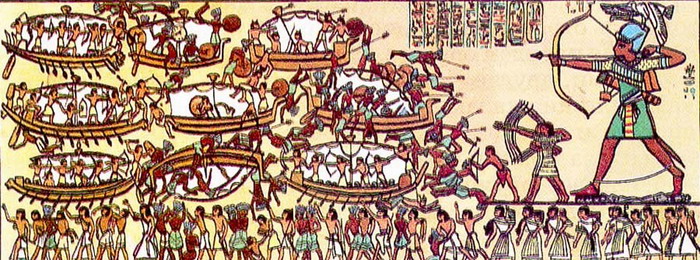
Mural from the Temple of Ramesses II - in the second year of the reign or really in 502, there was an invasion of the pirates of the Sherdans - the People of the Sea.

Figure No. 2. Drawing of the mural with the "People of the Sea" - at the bottom right, pirate warriors on boats with round shields and horns on their helmets.
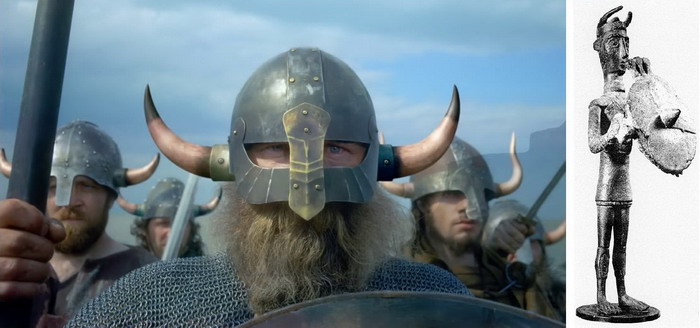
Ordinary Vikings and Varangians, on the right an "ancient" Egyptian figure of a warrior of the "People of the Sea".
| In 502–506 the Roman-Persian or Anastasian War took place. They say that the Emperor Anastasius twice refused to pay tribute to Kavad I, so the Persians attacked Theodosiopolis and Amida in 502. The Byzantines sent three corps, which fought with varying success, until in 505 they concluded a truce, and in 506 they signed a Peace Treaty. As a result Anastasius was forced to pay the Persians a large amount of gold [19]. The Egyptian chronicles described the "Persian" war in detail. At the beginning of the reign of Ramesses II, in the 4th year of his reign (504), troops were sent to Syria to repel the Hittites. In 505 the Battle of Kadesh on the Orontes took place. The Hittite army consisted of a variety of mercenaries. The opponents bled each other out, and as a result, a Peace Treaty was concluded, according to which the Egyptians returned home with honor. The war is described in the Poem of Pentaur [21]. The text of the peace treaty is preserved on the walls of the Karnak Temple. It is also claimed that the text of the treaty in the Hittite language was found in 1906 in the Bogazkoy Archive [22]. The texts were deciphered by Bedřich Hrozný in 1915. The author believes that the artifacts of the Bogazkoy Archive, as well as the tablets of the Peace Treaty of Ramesses II with the Hittites, are a new replica and a forgery of the participants of the historical complex. Accordingly, the Roman-Persian War of 502–506 is actually the war of Egypt with New Rome. The Sasanids remained within the traditional territory of Persia and India for many decades and centuries, and the Pharaohs of the New Kingdom dominated Rome and Byzantium in the period 240–640.
In 526–532 there were military clashes in Georgia and Armenia between Byzantine and Persian troops. As a result of another "victory" of the Romans, Constantinople was forced to pay a tribute to the Persians in the amount of 11 thousand pounds of gold. There is no information about these clashes in the Egyptian chronicles.
In 541–562 there was a Civil War between Constantinople and Persia for control of part of the territory of Georgia. As a result of the" victory", the Romans gained control of Lazica, but were forced to pay an annual tribute to the Persians. The Egyptians have no information about these clashes.
Synchronization of the chronicles of Rome and Egypt is also possible for several astronomical elements. In particular, the Temple of Hathor has two Zodiacs (the Round and Long Zodiac of Dendera). According to the historian N. A. Morozov and our reconstruction of history [5–10], the dating of the beginning of the construction of the Temple of Hathor under Ramesses II corresponds to 540, and the construction of the second stage of the Temple under Pharaoh Merneptah dates back to 568.
| 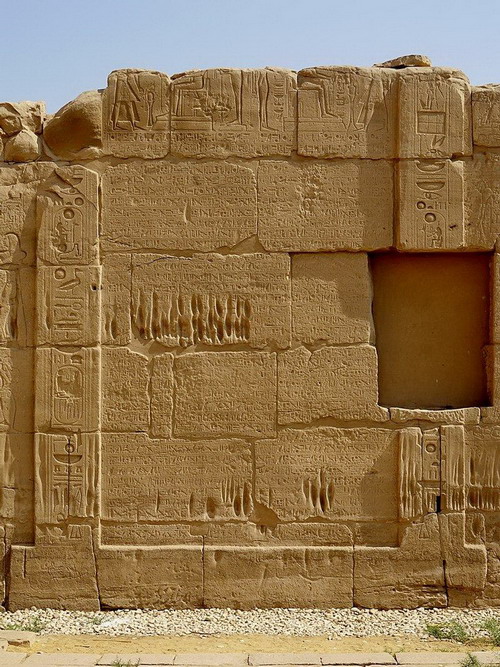
The text of the Peace Treaty with the Hittites in Egypt. It is clearly visible that the text of the agreement has been redacted (the destruction of individual phrases) by the participants of the historical complot.
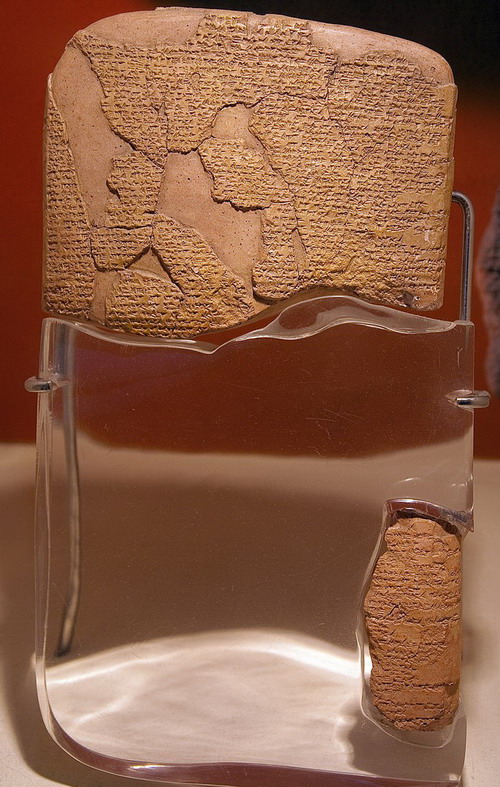
A tablet of the supposedly ancient Peace Treaty of the Hittites with the Egyptians from the Bogazkoy archive (found in 1906). A new fake model.
| In 572–591 the Iranian-Byzantine War for Nisibis took place. During the war, Shah Khosrow II Parviz escaped from his rebellious troops to Byzantium in 589 and after the joint victory of the Romans and Persians over the rebels in 591, he returned to the throne of Persia. In the Egyptian chronicles of Pharaoh Merneptah, these events are described as an uprising in Asia in the 6th and 7th years of the reign, i.e. in 572–574. In the annals, it is noted that Merneptah helped the Hittites with troops and sent bread to the starving. It is noted that Merneptah defeated the People of the Sea, who began to serve him as mercenaries. During the reign of the Pharaoh Israel is mentioned for the first time in history (The Merneptah Stele). According to the author's reconstruction, Egypt was attacked by Vikings and Varangians on boats, representing part of the troops of Israel or the Great Bulgaria of the Khagan Bayan. A few decades later Khagan Kubrat managed to create a Great Israel or Great Bulgaria of the VII century.
In 602–628 the Iranian-Byzantine War took place, affecting vast areas of Asia Minor, Mesopotamia, Palestine and North Africa [23]. This time we are talking about the real attack of the Persians in 602 on the territory of Byzantium and Egypt after the illegal accession of the Emperor Phocas. The offensive continued after the ascension to the throne of the Emperor Heraclius in 610, whom the author identifies with the Khagan Kubrat [5–10]. Already in 611 the Persians invaded Syria, and in 614 Palestine fell. In 615 the conquest of Egypt began, and in 618 Egypt came under the control of the Sasanids. In 622 Heraclius / Kubrat assumed command, but it was not until 628 that the war ended in a Byzantine victory, when Shah Khosrow II Parviz was executed by the rebels.
Egyptian sources have described this war in detail during the reigns of Queen Twosret, the Pharaohs Setnakhte and Ramesses III. In 602 the Syrian Irsu appeared who rebelled in Syria and Palestine and attacked Egypt in order to seize the throne [24]. With the accession of Ramesses III in 606 Egypt began to fight against the Persian invaders. In the 8th and 11th years of his reign, military companies in Palestine and Syria are described. First the Pharaoh repelled the attack People of the Sea – the Vikings/Israelites then fought with the Persians. According to the Byzantine chronicles, Egypt was conquered in 618. Therefore, no earlier than 618 a military operation to liberate Egypt is possible, when the Egyptians fought together with the Byzantine army against the Sasanids. After the expulsion of the Persians in the 630s, the Egyptian annals [25] speak of sending a multi-year expedition to Punt/Pont (Pontus) for copper.
According to the author's reconstruction [5–7], the expedition of Ramesses III was sent through the Greek area – Attica [25] to the Pontus – Black Sea, then the ships on the Don rose to the portage to the Volga/Ra/Itil, crossed the Volga and sailed to the Urals. Several tens of thousands of copper ingots were produced in the Southern Ural mines. The Egyptians purchased the local goods of the Bulgar and Khazaria (Mitanni or Naharina country) and returned home safely with the copper after a couple of years of travel. It is possible that the Emperor Heraclius / Khagan Kubrat gave permission for this expedition to his military ally in the coalition against the Sasanids.
A brief respite between the wars for Egypt ended with an attack by the Arabs under the command of Amr ibn al-As in 640. The author believes that the Arabs conquered the northern part of Egypt – its Delta, but the deep Nomes of the country retained their independence. In 658 Amr ibn al-As again conquered Egypt and became the Governor of the country. After that came the time for victories and the conquest of territories of Egypt by the Umayyad Caliphate, which was replaced by the rule of the Abbasid Caliphate in the 750s. After 640 Ancient Egypt began to degrade and disintegrated into separate Nomes, which were ruled by weak Governors who called themselves Pharaohs and used ancient magnificent titles that had no relation to reality.
The last link between the chronicles of Rome and Egypt is an astronomical phenomenon – the Annular Solar Eclipse of the 98th Saros, which occurred on August 8, 891. This was the last year of the life of Pharaoh Osorkon and the 15th year of the reign of Pharaoh Takelot I. An interesting fact is for 40 years there was the only one Solar Eclipse observed in Egypt, so it got into the chronicles. The Pharaohs of the XXII dynasty were in fact the last rulers to retain ancient traditions and titles. The entire late history of Ancient Egypt is the result of fraud and the fruit of speculation by the participants of the scientific complot.
| 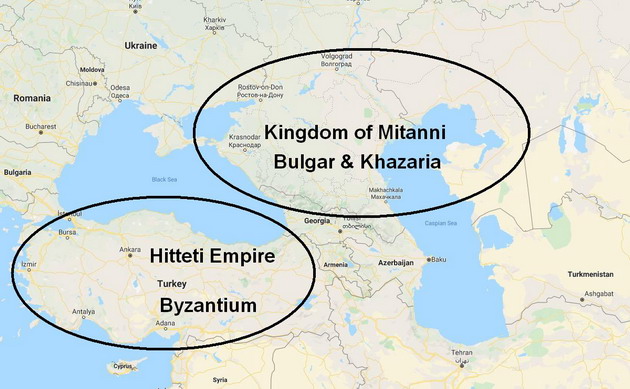
Figure No. 1. Map with the location of the Hittite Empire - the Byzantine Empire and the kingdom of Mitanni - Bulgar and Khazaria.
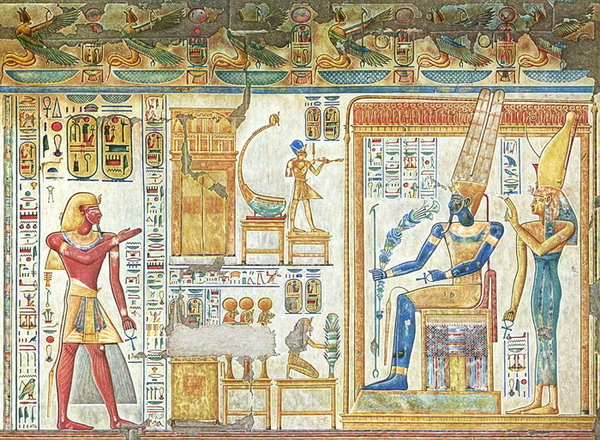
A mural from the tomb of Pharaoh Ramesses III, dated by the author to the 620s.
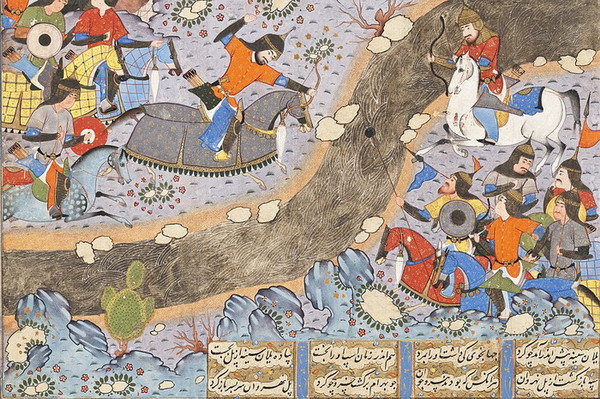
Drawing depicting the attack of the troops of Shah Khosrow II Parviz, a contemporary of Pharaoh Ramesses III, 620s.
| Conclusions of our research: The author's analysis of the annals for the correspondence of the events of military companies and astronomical phenomena of Ancient and New Rome, Ancient Egypt and the Sasanian Empire made it possible to synchronize the chronicles of these countries and confirm the chronological shift in the history of Egypt by 1780 years and the complot of historians to disguise the deeds of the New Kingdom of Egypt behind the non-existent activity of Persia. Most of the military campaigns studied in the 230–628 were fought between the Pharaohs of the New Kingdom of Egypt and Byzantium, and in part of the wars, the Romans and Egyptians acted as allies against the Sasanian Empire. The New Kingdom fell to Persia only in the last war of 602–628. The author attests to the political and military dominance of the New Kingdom of Egypt over New Rome in the period 330–628, when the territories of North Africa, the Nile Delta, Palestine, Syria and Mesopotamia belonged to Egypt, with the exception of some coastal cities. Pr. Dr. Valeriy Viktorovich Kubarev. 06–29.03.2021.
Bibliography:
1. Gimbutas, M. (1964) Bronze Age Cultures in Central and Eastern Europe. Mouton.
2. Gimbutas, M. (1977) The first wave of Eurasian steppe pastoralists into Copper Age Europe. J. of Indo–European Studies, vol. 5.
3. Gimbutas, M. (1974) The God and Goddesses of Old Europe. 7000–3500 B. C.
4. Gimbutas, M. (1980) The Kurgan wave № 2 (c. 3400–3200 B. C.) into Europe and the following transformation of culture. J. of Indo–European Studies, vol. 8.
5. Kubarev V.V., Vedas of Russ, IP MEDIA, M., 2009. ISBN 9781-93252567-0. Link: Link: http://www.kubarev.ru/ru/content/251.htm
6. Kubarev V.V., Short Chronology of Ancient Egypt, EESA, #6 (46) 2019, Part. 4, pp. 30–58.
7. Kubarev V.V., Localization of Ancient Rome, EESA, #7 (47) 2019, Part. 4, pp. 28–59.
8. Kubarev V.V., Chronology of monotheistic religions, EESA #8 (48) 2019, Part. 6, pp. 31–67.
9. Kubarev V.V., Astronomical dating of Biblical events, EESA #3 (55) 2020, Part. 2, pp. 24–35, link: https://eesa-journal.com/wp-content/uploads/EESA_3_55_march_2020_part_2.pdf
10. Kubarev V.V., Synchronization of historical and religious Chronicles, East European Scientific Journal (Warsaw, Poland), #5 (57), 2020 part 5. pp. 21–30. Link: https://eesa-journal.com/wp-content/uploads/EESA_5_57_May_2020_part_5.pdf
11. M. Liverani, «The collapse of the Near Eastern regional system at the end of the Bronze Age: the case of Syria», in Centre and Periphery in the Ancient World, M. Rowlands, M.T. Larsen, K. Kristiansen, eds. (Cambridge University Press) 1987.
12. Aelius Lampridius.
13. Вейгалл А. Великие правители Древнего Египта. — С. 248—258.
14. Theophanes the Confessor, Chronicles.
15. Авдиев В. И. Военная история Древнего Египта. — Т. 2. Период крупных войн в Передней Азии и Нубии в XVI—XV вв. до н. э. — С. 97—159.
16. Gabriel, R. A. Thutmose III: the military biography of Egypt’s greatest warrior king. — Dulles, VA: Potomac Books, Inc., 2009.
17. Mosig-Walburg K. Römer und Perser: vom 3. Jahrhundert bis zum Jahr 363 n. Chr. — Computus Druck Satz Verlag, 2009. – 383 p. – ISBN 978-3-940598-02-8.
18. Socrates Scholasticus, VII, 18.
19. Пигулевская Н. В. Месопотамия на рубеже V—VI вв. н. э. Сирийская хроника Иешу Стилита как исторический источник / Отв. редактор акад. И.Ю. Крачковский. — Труды института востоковедения. — М.‒ Л.: Издательство Академии наук СССР, 1940. — Т. XXXI. — стр. 105 – 116.
20. Emanuel, Jeffrey P. "Sherden from the Sea: The Arrival, Integration, and Acculturation of a Sea People". Journal of Ancient Egyptian Interconnections 5-1: 14-27 (2013).
21. Papyrus Raifet-Sallier.
22. Bogazkoy Archive.
23. Kaegi, Walter Emil. Heraclius: Emperor of Byzantium. — Cambridge University Press, 2003. — ISBN 0521814596.
24. Vivienne G. Callender, Queen Tausret and the End of Dynasty 19, Studien zur Altägyptischen Kultur, Bd. 32, (2004), pp. 81–104.
25. Papyrus Harris I, 78, 1–4. Facsimile of an Egyptian Hieratic papyrus of the reign of Ramses III.
The text of the article in Word format:
19278.docx |
|

